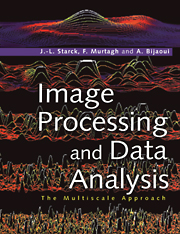Book contents
- Frontmatter
- Contents
- Preface
- 1 The wavelet transform
- 2 Multiresolution support and filtering
- 3 Deconvolution
- 4 1D signals and Euclidean data analysis
- 5 Geometric registration
- 6 Disparity analysis in remote sensing
- 7 Image compression
- 8 Object detection and point clustering
- 9 Multiscale vision models
- APPENDIX A Variance stabilization
- APPENDIX B Software information
- APPENDIX C Acronyms
- Bibliography
- Index
9 - Multiscale vision models
Published online by Cambridge University Press: 30 October 2009
- Frontmatter
- Contents
- Preface
- 1 The wavelet transform
- 2 Multiresolution support and filtering
- 3 Deconvolution
- 4 1D signals and Euclidean data analysis
- 5 Geometric registration
- 6 Disparity analysis in remote sensing
- 7 Image compression
- 8 Object detection and point clustering
- 9 Multiscale vision models
- APPENDIX A Variance stabilization
- APPENDIX B Software information
- APPENDIX C Acronyms
- Bibliography
- Index
Summary
Artificial vision and astronomical images
Astronomical images contain typically a large set of point-like sources (the stars), some quasi point-like objects (faint galaxies, double stars) and some complex and diffuse structures (galaxies, nebulae, planetary stars, clusters, etc.). These objects are often hierarchically organized: star in a small nebula, itself embedded in a galaxy arm, itself included in a galaxy, and so on. We define a vision model as the sequence of operations required for automated image analysis. Taking into account the scientific purposes, the characteristics of the objects and the existence of hierarchical structures, astronomical images need specific vision models.
For robotic and industrial images, the objects to be detected and analyzed are solid bodies. They are seen by their surface. As a consequence, the classical vision model for these images is based on the detection of the surface edges. We first applied this concept to astronomical imagery (Bijaoui et al, 1978). We chose the Laplacian of the intensity as the edge line. The results are independent of large-scale spatial variations, such as those due to the sky background, which is superimposed on the object images. The main disadvantage of the resulting model lies in the difficulty of getting a correct object classification: astronomical sources cannot be accurately recognized from their edges.
We encounter this vision problem of diffuse structures not only in astronomy, but also in many other fields, such as remote sensing, hydrodynamic flows or biological studies. Specific vision models were implemented for these kind of images.
- Type
- Chapter
- Information
- Image Processing and Data AnalysisThe Multiscale Approach, pp. 243 - 262Publisher: Cambridge University PressPrint publication year: 1998

